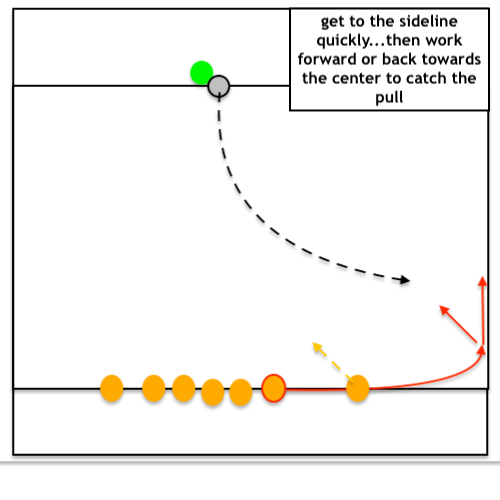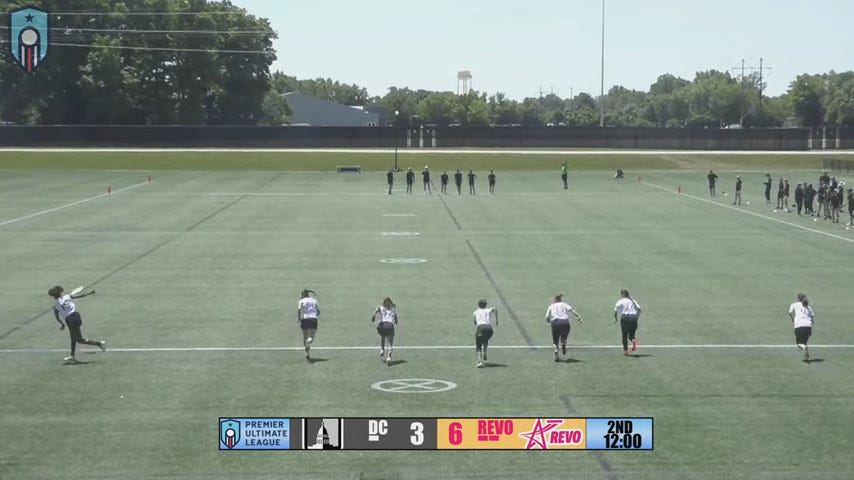A quick tip on catching pulls: get to the sideline
It's easier to judge the pull when you're already on the sideline
Here's a situation that comes up enough to be worth thinking about:
Your team is receiving the pull. The disc takes a curved path that'll result in it landing near the sideline.
If it lands in bounds and you don't catch it, you've wasted precious moments when you could've been making progress before the defense arrives.
If you catch the disc but it was going to land out of bounds, you lose the chance to center the disc for free.
What do you do?
(Side note: as a friend pointed out to me once, just because the disc is landing out of bounds, you shouldn't automatically center it. If you can end up in a better position by tapping it in on the sideline and immediately starting play, do that instead. Starting flow immediately can be worth the few extra yards you might lose by not taking it to the brick mark. Note that you don't need to worry about being out of bounds on your catch—you can simply catch the pull out of bounds and immediately put it into play at the appropriate spot.)
Here's what I like to do: I get to the sideline as quickly as possible. I've found that being on the sideline early makes it easiest to judge where the pull is landing. If I'm on the sideline, I only have to ask myself a very basic question: Will the disc land to my left or to my right?
I find that answering this question is much easier than doing whatever mental calculations it takes to figure out whether the disc will land ten or eleven feet to (for example) my left. There's probably some "evolutionary" explanation for this—if you want to avoid death, you have to be extremely good at figuring out whether or not that flying thing is going to hit you in the head. It's less critical to be able to figure out if that flying thing will land 10 or 11 feet to your left.
Another way to think of it: if you put your foot on the sideline, you know where the sideline is. Knowing where the sideline is, you can keep your eyes on the disc. If you don't know exactly where the sideline is, you may need to take your eyes off the disc to re-orient yourself with respect to the sideline. Looking back and forth between the disc and sideline makes it harder to be sure of the precise location of both of them.
There's one other benefit I've come to enjoy about getting to the sideline early—you can catch the pull with your momentum leading you back towards the middle of the field. I find it much easier when everything is in front of me—I catch the pull moving "forward" and then throw it to a teammate who's in front of me. If I get to the sideline early, all of my subsequent actions take me back towards the center of the field, without ever needing to change direction. If I get to the pull late, I might need to catch it while moving to my left and then stop my momentum before throwing it back to the right.
Hopefully that’s clear enough, here’s a simple diagram in case it helps:
Catching pulls this way takes proactive-ness — as many good things in ultimate do — but it's worth it to avoid being trapped on the sideline.
Hopefully there are enough examples below to convince you that near-sideline pulls are a common occurrence—and that you don’t want to be trapped on the sideline when a disc unexpectedly hits the ground inbounds.
Examples
I included two examples in a previous article, PUL's Pulls:
Here's the first:
and second:
I noted back then how DC lined up for the pull with everyone clumped together:
To make getting to the sideline as easy as possible, start with where you set up before the pull. If your fellow handler is to the left of you, move further to the right. With one handler 10 yards from one sideline and the other handler 10 yards from the opposite sideline, there's a pull catcher within 10 yards of any point across the width of the field.
Here's a pull from a 2024 Raleigh Radiance vs. DC Shadow game where the pull lands right near the sideline and the DC players are forced to play it from there:
The DC player seems to think the pull landed out of bounds, and only realizes after looking at the observer that it landed in. The Raleigh defense is set up before the first pass. Looking at the DC players jogging down the field, it's pretty obvious they could've caught the pull if they'd wanted to.
Here's a pull from Portland Rising vs. NY Gridlock (in 2023) where the pull lands near the sideline. NY doesn't catch it and as a result can't get off a centering pass before the defense arrives:
The pull has nearly 6 seconds of hangtime, so New York had more than enough time to get to it.
All of these examples are situations where the offense certainly had time to catch the pull. I'd argue that in every case they should've caught the pull. Even if they catch the pull with a foot out of bounds, all they need to do is set a pivot foot and begin play.
The famous "Christian Foster monster pull" may be an example of this as well. One of the YouTube commenters mentions that it looks like it may have been going out, though another commenter disagrees. Either way, I think it's harder for the pull-catcher to judge because they're jogging towards the sideline instead of already there.
I have sympathy for the pull-catcher here, as the pull is so monstrous it ends up changing direction—the receiver seems to think it's heading towards the other side of the field for the first five seconds or so!
Here's an example of someone who seems to be roughly using the technique I'm suggesting. It's from another Portland Rising vs. NY Gridlock game, in 2024. Watch how the Gridlock player gets all the way to the sideline to read the pull:
The pull goes out of bounds, and the Gridlock player knows that for sure as they're toeing the sideline while watching the disc fall.
Here's one more example of a pull that was caught near the sideline. Julianna Werffeli of San Francisco Fury fields this pull from Fury's 2023 national semifinal against Brute Squad:
It's hard to tell if the pull would've landed inbounds—it was going to be close. I like Julianna's decision to catch it here—her give-and-go gets Fury past the brick mark with just two passes.
This pull can exemplifies how getting to the sideline early is useful for playing with forward momentum. Werffeli catches the pull just as she stops moving to her right, and then pivots back to the left to center the disc before cutting to the middle herself. There's nothing wrong with this, per se, but in my experience it's slightly better to be able to catch the disc already moving towards the middle, and have all of your momentum working in the same direction. I feel more secure catching my pulls b/c I don't have to worry about changing my momentum, and my forward motion translates optimally into a give-and-go.
In some late-breaking pre-publication news, here’s one final example from the 2024 PUL championship game:
I think Valeria Cardenas would’ve had a slightly better read on the disc if she’d already been closer to the sideline. But I like her decision not to catch the pull here — since the disc was coming from out of bounds (unlike my diagram and unlike most of the pulls above), the out of bounds pull was worth ~50 yards of progress. That’s a risk worth taking! When the disc is trailing towards the sideline from in bounds, the field position won’t change much if it lands out. Not surprising that one of the best players in the world has a good intuition for risk vs. reward here.
Final thoughts
In my opinion, you should get to the sideline quickly to make it easy to read close-call pulls.
Whether you like my suggestion or not, hopefully there’s enough examples here to convince you that pulls near the sideline happen frequently enough that you should have a strategy for them.
[Update (2025-07-08)]:
Here’s another example from the U24 worlds final. Misreading the disc doesn’t directly cause the turnover, but their offense certainly could’ve started with better flow if the pull catcher had correctly decided to catch it:

